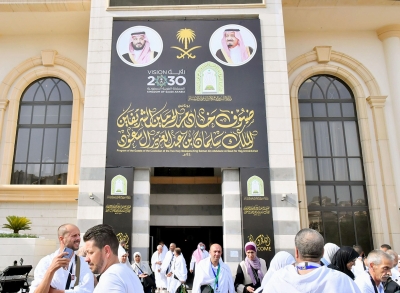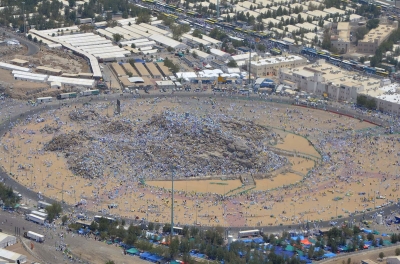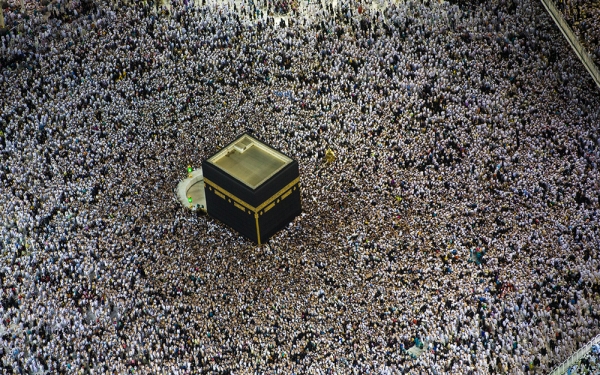
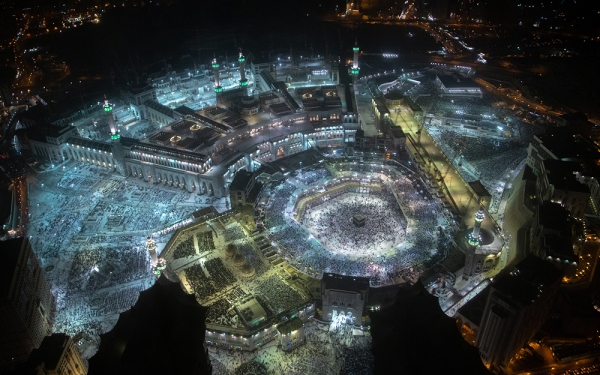
Hajj is the fifth pillar of Islam and one of the Islamic rituals that the Kingdom of Saudi Arabia organizes every year, hosting millions of Muslims from different parts of the world to perform the Hajj rituals in Makkah al-Mukarramah and the holy sites.
The performance of the Hajj pilgrimage involves specific acts of worship during the period between the eighth and thirteenth of the month of Dhu al-Hijjah each year, in the Grand Mosque and the holy sites. For its validity, it is required to complete its four pillars: Ihram, standing at Arafat, Tawaf al-Ifadah, and Sa'i.
All Hajj rituals are performed within the boundaries of the Haram, except for the standing at Mount Arafat, which is outside those boundaries. Pilgrims can enter into the state of Ihram for Hajj from the beginning of the month of Shawwal, as it is one of the three months of Hajj.
The state of Ihram is assumed from the Miqat by entering it, passing through it, or flying over it in an aircraft. The Hajj rituals are centered around six days, starting with the Tarwiyah and ending on the last day of the Days of Tashreeq, which corresponds to the thirteenth day of the month of Dhu al-Hijjah. Pilgrims are permitted to hasten from Mina after performing the Stoning of the Jamarat on the twelfth day, completing their Hajj rituals.
Saudi Arabia has introduced a number of digital programs for Hajj services to automate procedures and tasks related to Hajj. These include applications that serve as intermediaries between various entities involved in Hajj, as well as service-oriented applications that help pilgrims access available services in an organized and facilitated manner.
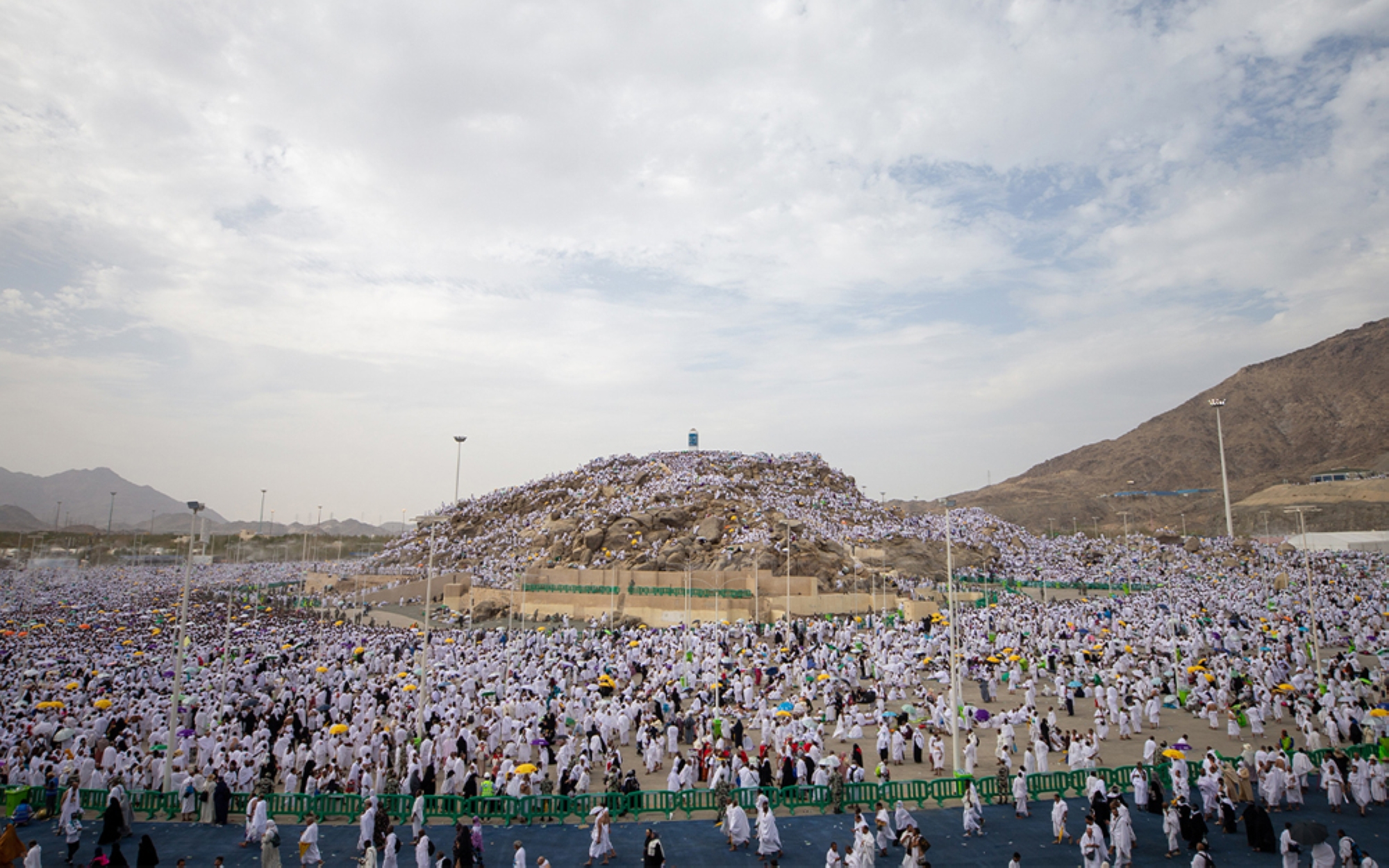
Definition of Hajj
In linguistic terms, Hajj means "to set out for a place". In religious terms, it refers to specific actions performed in specific places at specific times. It means "setting out for the Kaaba to perform the rituals" or "setting out for the House of Allah in a specific manner at a specific time with specific conditions." However, the acts of Hajj are not limited to the Grand Mosque but also include the holy sites.
The specific actions include everything the pilgrim does and avoids, while the specific places include the Sacred Mosque and the holy sites. The specific time refers to the period for performing the Hajj rituals.
The ruling on Hajj
Hajj is one of the five pillars upon which Islam is built. The conditions for its obligation are five: Islam, sanity, puberty, freedom, and capability.
The conditions for Hajj are divided into three categories. The first category includes what is a condition for obligation and validity, which are Islam and sanity. Hajj is not obligatory for a non-Muslim or an insane person, and it is not valid for them because they are not eligible for acts of worship. The second category includes what is a condition for obligation and sufficiency, which are puberty and freedom. These are not conditions for validity. The third category includes what is a condition for obligation only, which is capability.
Hajj is obligatory for every capable adult immediately if they are able, as evidenced by the Quranic verse: "And [due] to Allah from the people is a pilgrimage to the House – for whoever is able to find thereto a way" (Quran 3:97). Therefore, Hajj is mandatory for those who are able, unlike those who are incapable, for whom Hajj is not obligatory. However, if someone is able physically and financially, then Hajj is obligatory for them. If they are able financially but not physically, due to old age or illness with no hope of recovery, then they should delegate someone to perform Hajj on their behalf.
Timing of Hajj
The timing of Hajj is during the months of Hajj. Allah says, "Hajj is [during] well-known months" (Quran 2:197), which are Shawwal, Dhu al-Qa'dah, and Dhu al-Hijjah. Ihram for Hajj is only valid during these months.
Locations of Hajj
Pilgrims must assume Ihram for Hajj from the designated locations established by the Prophet Muhammad, peace be upon him (PBUH), where the residents and those passing through these locations intending to perform Hajj or Umrah should assume Ihram. These locations are: Dhu al-Hulayfah for the residents of al-Madinah al-Munawwarah and others passing through, now known as 'Abyar Ali'. Al-Juhfah for the residents of Syria, Egypt, and Morocco, which has been replaced by another location in Rabigh, seventeen km away. Qarn al-Manazil for the residents of Najd, the Gulf states, and those traveling from their direction, known as 'al-Sayl al-Kabir'. Wadi Muharram for the residents of Ta'if and those passing through on the route of Huda. Yalamlam for the residents of Yemen and all those passing through. Dhat Irq for the residents of Iraq and all those passing through that route. The people of Makkah al-Mukarramah assume Ihram for Hajj from their homes.
Pilgrims who do not pass through the designated (Miqat) locations for assuming Ihram, whether by air or sea, must assume Ihram at the nearest of these (Miqat) locations to them.
Pillars and Duties of Hajj
The pillars of Hajj are the intention to assume Ihram, standing at Arafat, circumambulation of the Kaaba, and the Sa'i between Safa and Marwah. Its obligations include assuming Ihram from the designated stations, standing at Arafat until sunset, staying overnight at Muzdalifah, performing the Halq (full shaving of the head) or Taqsir (trimming the hair), staying overnight in Mina during the days of Tashreeq, stoning the pillars, and performing the Farewell Circumambulation.
The rituals of the Day of Tarwiyah
The Day of Tarwiyah is the eighth day of Dhu al-Hijjah, and the first day of Hajj. On this day, pilgrims begin their journey to Mina, where they stay until dawn of the following day, which corresponds to the Day of Arafat. They perform shortened (qasr) prayers of Dhuhr, Asr, Maghrib, Isha, and Fajr, without combining them.
The Day of Arafat
The Day of Arafat is the ninth day of Dhu al-Hijjah, and the standing at Arafat is the main pillar of Hajj. Pilgrims start arriving there from sunrise and stay there until sunset.
Staying overnight at Muzdalifah
It is the night when pilgrims depart from Arafat to Muzdalifah at sunset to perform combined and shortened Maghrib and Isha prayers. They spend the night there and pray Fajr before leaving, except for those who are weak, as permitted by the Prophet Muhammad (PBUH), to depart before Fajr. Spending the night in Muzdalifah is one of the obligations of Hajj.
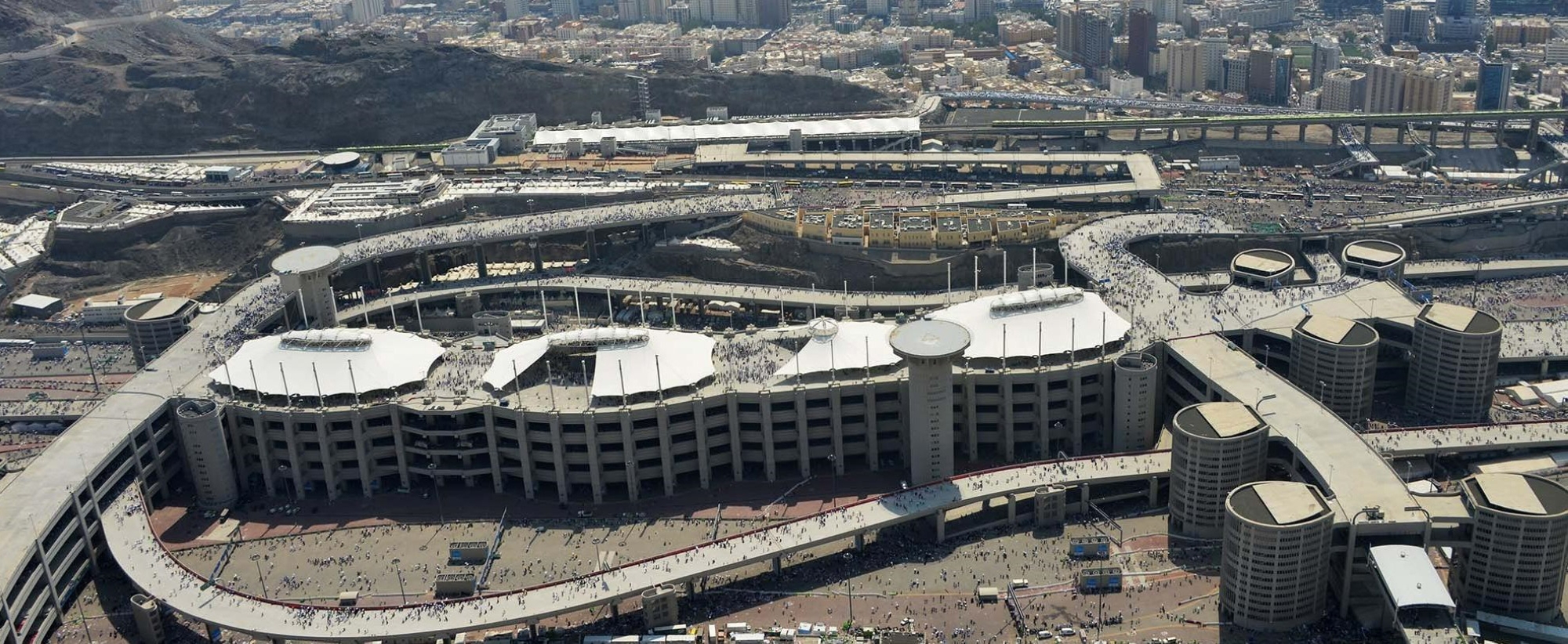
Eid al-Adha
It is called the Day of Sacrifice because pilgrims sacrifice their sacrificial animals (hady) on this day. It is the first day of stoning the Jamarat, where the largest pillar, Jamrat al-Aqabah, is stoned with seven pebbles. It is also the day for shaving the head or trimming the hair, and for performing the Tawaf al-Ifadah and Sa'i for those performing Hajj al-Tamattu', as well as for those performing Hajj al-Qiran or Hajj al-Ifrad who did not perform Sa'i during the Tawaf of arrival.
Tashreeq Days
These are the days of the eleventh, twelfth, and thirteenth of Dhu al-Hijjah, during which pilgrims stay in Mina and perform the stoning of the three Jamarat (pillars). They begin by stoning the Jamrat al-Sughra (the smallest pillar), then the Jamrat al-Wusta (the middle pillar), and finally the Jamrat al-Aqabah (the largest pillar), following the tradition of the Prophet Muhammad (PBUH). Each day, they throw seven pebbles at each of the three Jamarat, totaling twenty-one pebbles per day. It is permissible for the pilgrim to hasten on the twelfth day and skip spending the night of the thirteenth, completing the stoning of the Jamarat on the following day.
Types of Hajj Rituals
Muslims perform Hajj through one of the three types of rituals: Tamattu', Qiran, and Ifrad.
1- Tamattu': In linguistic terms, Tamattu' means to benefit. In Hajj, it refers to performing Umrah during the months of Hajj, then after completing it, entering into the state of Ihram for Hajj in the same year. The person performing Tamattu' is so named because they benefit from what is not permissible for a person in Ihram to do, from the time of completing Umrah until the time of performing Hajj. They also benefit from combining two rituals into one journey.
2- Qiran: Linguistically, "Qiran" means combining two things completely. In Hajj, it refers to combining Hajj and Umrah with one Ihram. This can be done by entering Ihram for both Hajj and Umrah together, or by entering Ihram for Umrah first and then including Hajj in the same Ihram before Tawaf.
3- Al-Ifrad: In language, "Ifrad" means singular or individual. In Hajj, it refers to intending to perform Hajj alone. The acts of the singular and the Qarin (one performing Hajj and Umrah together) are the same. The Qarin only needs to perform one Tawaf for both Hajj and Umrah, and he is restricted to the acts of Hajj. All the acts of Umrah are included in the acts of Hajj.
Historical Landmarks in Hajj
Many historical landmarks are associated with the Hajj season, including:
Masjid Namirah in Arafat: It is the largest mosque in the holy sites, witnessing several expansions during the Saudi era. One of these expansions was ordered by King Abdulaziz Al Saud, with a length reaching 340 m from east to west, and a width of 240 m from north to south, covering an area of 110,000 m2. There is a shaded courtyard behind the mosque covering eight thousand m. The mosque can accommodate around four hundred thousand worshippers, and it has six minarets, each sixty m high, three domes, and ten main entrances with sixty-four doors. The mosque was first established at the location where the Prophet Muhammad (PBUH) delivered his farewell sermon during the Hajj of Farewell in the middle of the second century AH. It is located west of the holy site and part of the western side of the mosque is in the Uranah Valley, which is one of the valleys of Makkah al-Mukarramah. The Prophet (PBUH) prohibited standing in that valley.
Masjid Khayf in Mina: Also known as the Mosque of the Prophets, it is where the Prophet Muhammad (PBUH) prayed and delivered his sermon during the Farewell Hajj. It is also a place where previous prophets prayed. The mosque is located at the foot of Mount Sabih in Mina, close to the Jamarat. It witnessed a reconstruction and expansion during the Saudi state era in 1987, increasing its area to 23,500 m, accommodating twenty-five thousand worshipers, and featuring four minarets.
Masjid al-Mash'ar al-Haram in Muzdalifah is located halfway between Masjid Namirah in Arafat and Masjid Khayf in Mina. The Prophet stayed there during his Farewell Pilgrimage, and it is situated on a mountain called "Qazah." Pilgrims head there after sunset on the day of Arafat. Initially a simple square structure with a limited area and no roof, it was expanded during the Saudi era to be ninety m long from east to west, fifty-six meters wide, and capable of accommodating over twelve thousand worshipers. It is adorned with two minarets, each thirty-two m high, and has several entrances on three sides.
Jabal al-Rahmah, also known as Mount Arafat or Arafah, is located east of the Arafat Plain, about twenty-two km east of Makkah al-Mukarramah. Pilgrims stand on it on the ninth day of the month of Dhu al-Hijjah, as it is one of the places they are commanded to stand at. It rises sixty-five m above the ground, with its highest point reaching 372 m above sea level.
Ministry of Hajj and Umrah
The Ministry of Hajj was established in 1962. It is the only ministry within the Council of Ministers whose headquarters is located in Makkah al-Mukarramah, due to its proximity to the holy places and sites. The organization of hosting the pilgrims began during the reign of King Abdulaziz Bin Abdulrahman Al Saud, who ordered the establishment of the General Directorate of Hajj. It was later renamed to the General Administration of Hajj under the supervision of the Minister of Finance. After about nine years, a royal order was issued to transform the administration into the Ministry of Hajj and Endowments. The ministry continued under this name until 1993, when a decision was made to separate the Endowments sector into an independent ministry, leaving the Ministry of Hajj responsible solely for Hajj affairs. The supervision over the affairs of the Two Holy Mosques and the factory for the Kiswa (cover) of the Kaaba was also removed from its jurisdiction. On May 7, 2016, a royal order was issued to modify the name of the Ministry of Hajj to become the Ministry of Hajj and Umrah.
The Ministry of Hajj and Umrah regulates Hajj affairs by setting policies, assessing their impact, planning, and monitoring. It designs services to enhance the Hajj experience, protects the rights of pilgrims, and oversees the services provided to them.
Royal Commission for Makkah City and Holy Sites
As part of Saudi Arabia's objectives to facilitate Hajj and improve services for pilgrims, the Royal Commission for Makkah City and Holy Sites was established in 2018. It works on developing plans and strategies to enhance services in Makkah al-Mukarramah and the holy sites by providing diverse, value-added experiences while considering the area's unique characteristics. It focuses on improving planning in Makkah al-Mukarramah, enhancing the quality of facilities and services, increasing capacity, proposing regulatory frameworks, monitoring performance, supervising projects, setting priorities, and enabling entities to implement the approved strategic direction for Makkah al-Mukarramah City. This aims to provide an experience that enhances high productivity.
Smart Hajj
Saudi Arabia has introduced several digital applications and programs dedicated to automating the processes and procedures related to Hajj, and the pilgrims of the Holy Kaaba, with the aim of completing requirements immediately or systematically. These include applications specifically for pilgrims, others for organizers, as well as applications that act as intermediaries between various entities involved in Hajj. There are also service applications that help pilgrims access available services in an organized and facilitated manner.
Pilgrims' e-track
The e-track system is one of the technological and smart programs during the Hajj season, serving all pilgrims coming from different parts of the world, as well as domestic pilgrims. It is a comprehensive system that includes mandatory contracts related to food, transportation, and accommodation from the arrival of the pilgrim until their departure. This ensures transparency, achieves necessary supervision over the implementation, and guarantees that each party complies with its responsibilities under the direct supervision of the Ministry of Hajj and Umrah.
The e-track system aims to enable pilgrims to choose what suits their needs by allowing them to access various Hajj programs and services through its electronic portal. It also enables them to contract electronically with Hajj companies according to their preferences. Additionally, it works to protect the rights of pilgrims by providing a dedicated electronic system for paying the value of contracts concluded between them and the companies and transferring requests for Hajj permits to the Ministry of Interior's systems to issue the necessary permits for Hajj after completing the contracts.
Pilgrim’s Smart Bracelet
The Pilgrim's Smart Bracelet " NUSK" project, launched by the Saudi Authority for Data and Artificial Intelligence (SDAIA) and the Pilgrim Experience Program, is a digital service that relies on data and the Internet of Things to develop operational and technical systems, providing a qualitative experience for pilgrims. The bracelet carries electronic smart information about the pilgrim and their health status, measures heart rate and blood oxygen levels, enables requesting emergency assistance both in terms of security and medical needs, and receives informational and guidance messages.
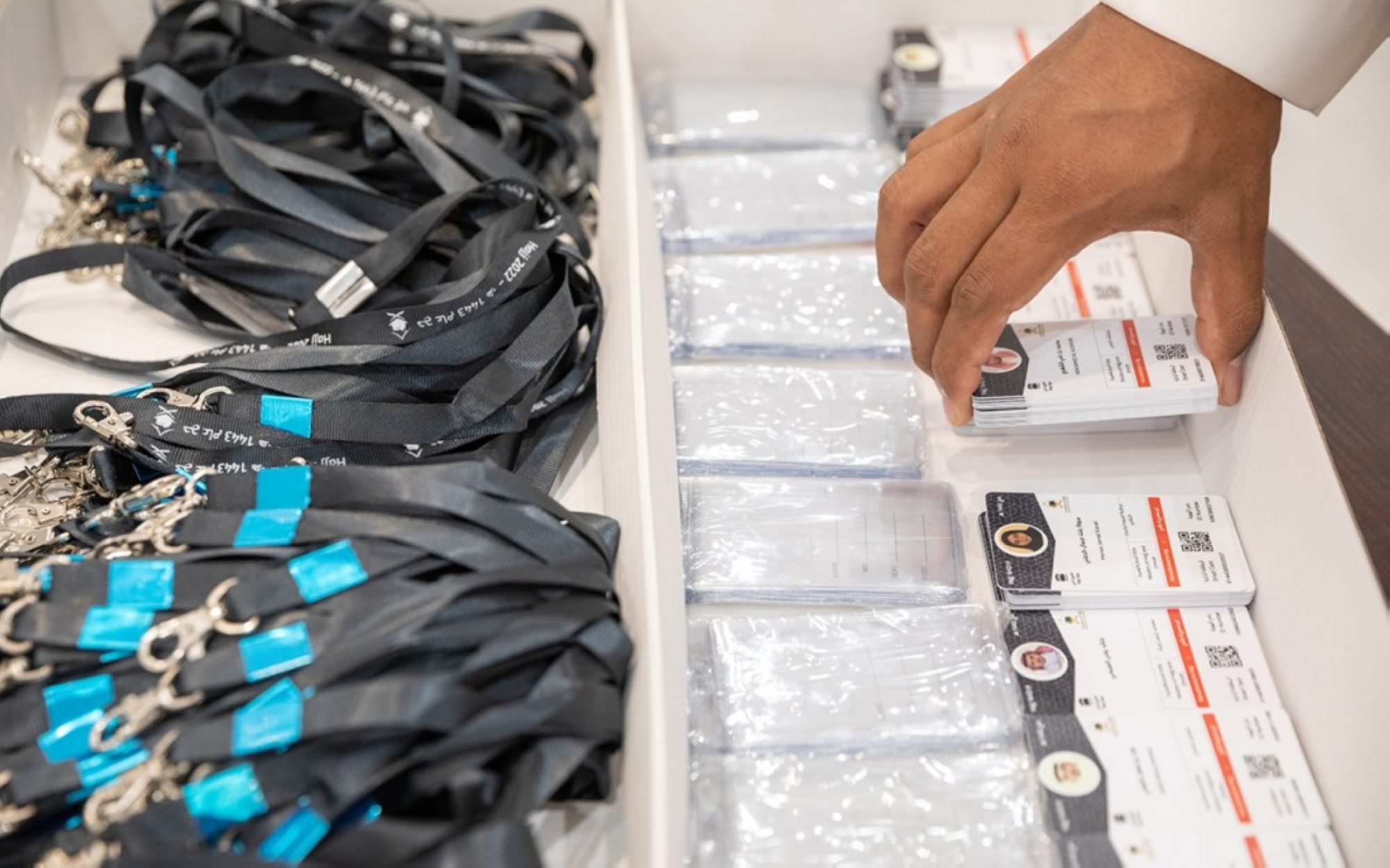
Smart Card
It is a service implemented by the Ministry of Hajj and Umrah, which is a digital identity for the pilgrim. It contains personal, medical, and residential information, as well as the pilgrim's group number, bus number, seat, accommodation building, and room number. It also includes their program schedule at gathering points and departure times.
The smart card allows pilgrims to access various facilities in the holy sites and quickly reach their accommodations. It includes Near Field Communication (NFC) technology for reading pilgrims' data by self-service devices. It also has a barcode that enables Hajj workers to access all the pilgrim's information.
Tawakkalna Application
The "Tawakkalna" application, affiliated with the Saudi Authority for Data and Artificial Intelligence (SDAIA), represents one of the smart Hajj tools. It carries a copy of the Hajj permit and the health status of the pilgrims. Through it, services for transportation between the holy sites and the Grand Mosque can be reserved, and it facilitates verifying the legality of the pilgrimage and the health conditions of the pilgrims.
Smart Hajj initiatives
To enhance the level of services provided to pilgrims, the "Service Monitoring" initiative works on improving the services provided to pilgrims in accommodation, transportation, and catering. It provides a smart mechanism for organizing transportation routes and creating additional spaces for pilgrims. Additionally, it activates the services of the "Tafwij" program, which is the control point for managing crowds through a digital system to prepare and monitor the plans for guiding pilgrims. The "E-System for the Holy Sites" initiative serves as a regulatory tool aimed at measuring the readiness of the holy sites facilities. The "Hajj Without Baggage" initiative is one of the prominent facilitations provided to pilgrims through an electronic system that ensures the arrival of luggage before travelers and shortens the time and procedures.
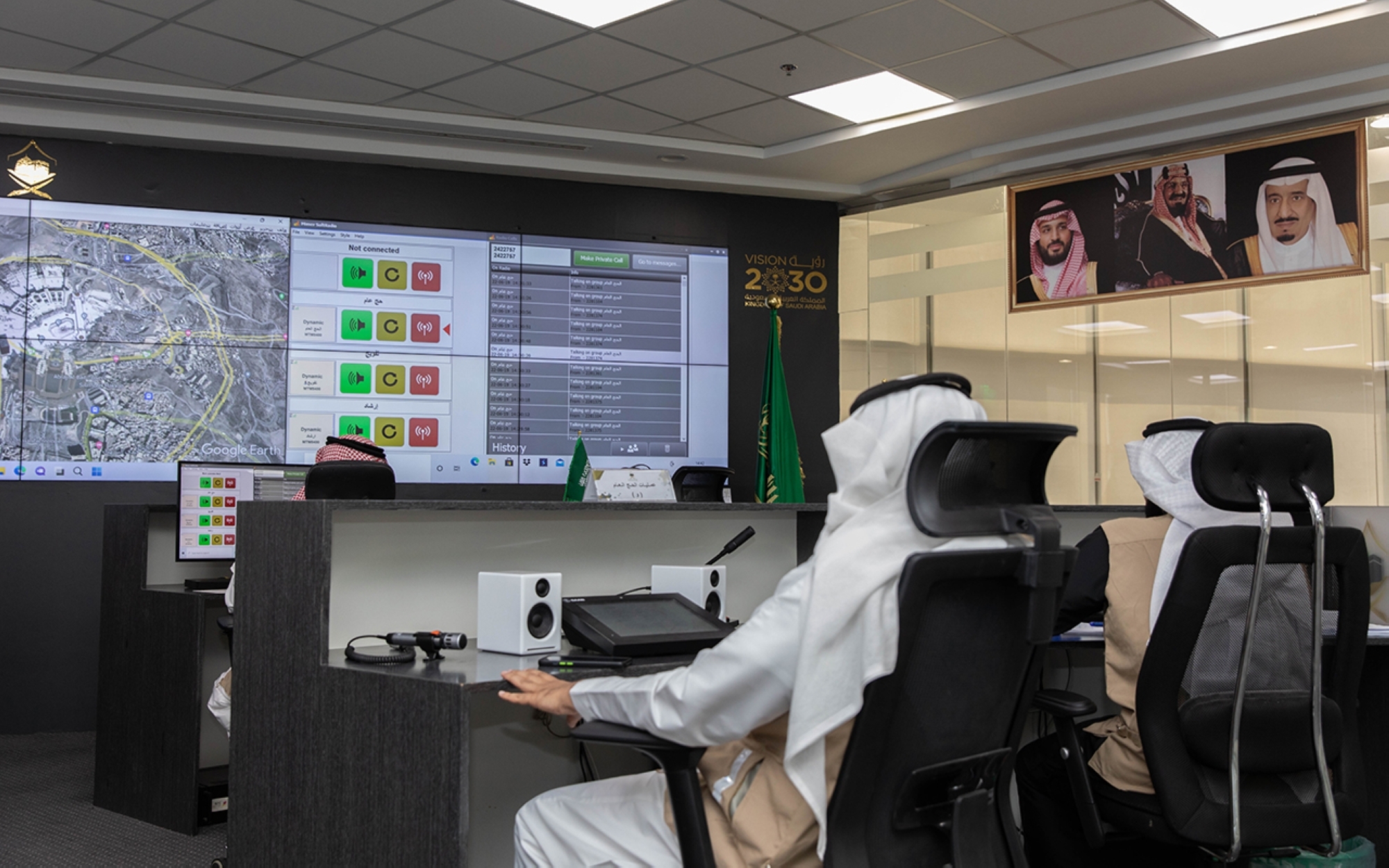
Smart Hajj applications
A group of applications dedicated to Hajj facilitate services and benefit from them through technological procedures based on smart applications. Among these, the Navigational Hajj and Umrah Locator App is a prominent tool for smart Hajj, containing digital maps of the holy sites, Makkah al-Mukarramah, and al-Madinah al-Munawwarah. These maps include facilities, buildings, camps in the holy sites, roads, streets, neighborhoods, and the locations of public facilities and services. The application operates based on the national address system, which is used to number buildings, facilities, and camps in the areas that accommodate pilgrims during the Hajj season. Additionally, the Nusuk App allows for booking Umrah and visitation rituals, and the "Adahi" project facilitates performing the sacrifice rituals. "Alharamain" application is one of the platforms for Hajj that contributes to providing services and information related to the Haram Mosque for pilgrims and visitors.
Another application for Hajj is the "Arafat Sermon" app, which is the first assistant for pilgrims and other Muslims from around the world to listen to and watch the Arafat sermon in several languages, including English, French, Persian, Malay, and Urdu. "Mutawaf" app includes several services such as the "Arshedni App" service to help pilgrims find their accommodation, a guide to the Haram containing several illustrated maps of the Grand Mosque and its services, and the "Ask Me" service to enable pilgrims to get answers to their questions at all times. The app also includes information or common misconceptions about Hajj, as well as phone numbers that pilgrims may need, prayer times, supplications, and remembrances.
The "Tarjuman" application is another smart Hajj tool that translates instruction signs in streets and squares into several languages without the need for internet usage. Additionally, "al-Maqsad" application aims to facilitate the tasks of pilgrims in determining their locations inside the Haram Mosque and finding the routes to the places they want to go without an internet connection. The "Manasikna" application is used to identify important locations for pilgrims such as mosques, shopping centers, and restaurants, and to search for the shortest routes to these places.
Among the aspects of smart Hajj is the "Tarwiyah" application, which aims to ensure the sustainability of water-related services in the vicinity of the holy sites. It includes a map to locate toilets, as well as a service for reporting water problems and malfunctions. It also provides information on the specific points for distributing Zamzam water and is available in seven languages to facilitate its use.
Among the smart Hajj applications are a number of health services, such as medical consultations available through the "Seha" application. This app provides access to a group of certified doctors who offer necessary consultations to pilgrims via audio and video, with a final assessment of the condition by the doctor. Additionally, there is the "Asefni" application for reporting emergencies, which allows for location identification and supports people with special needs.
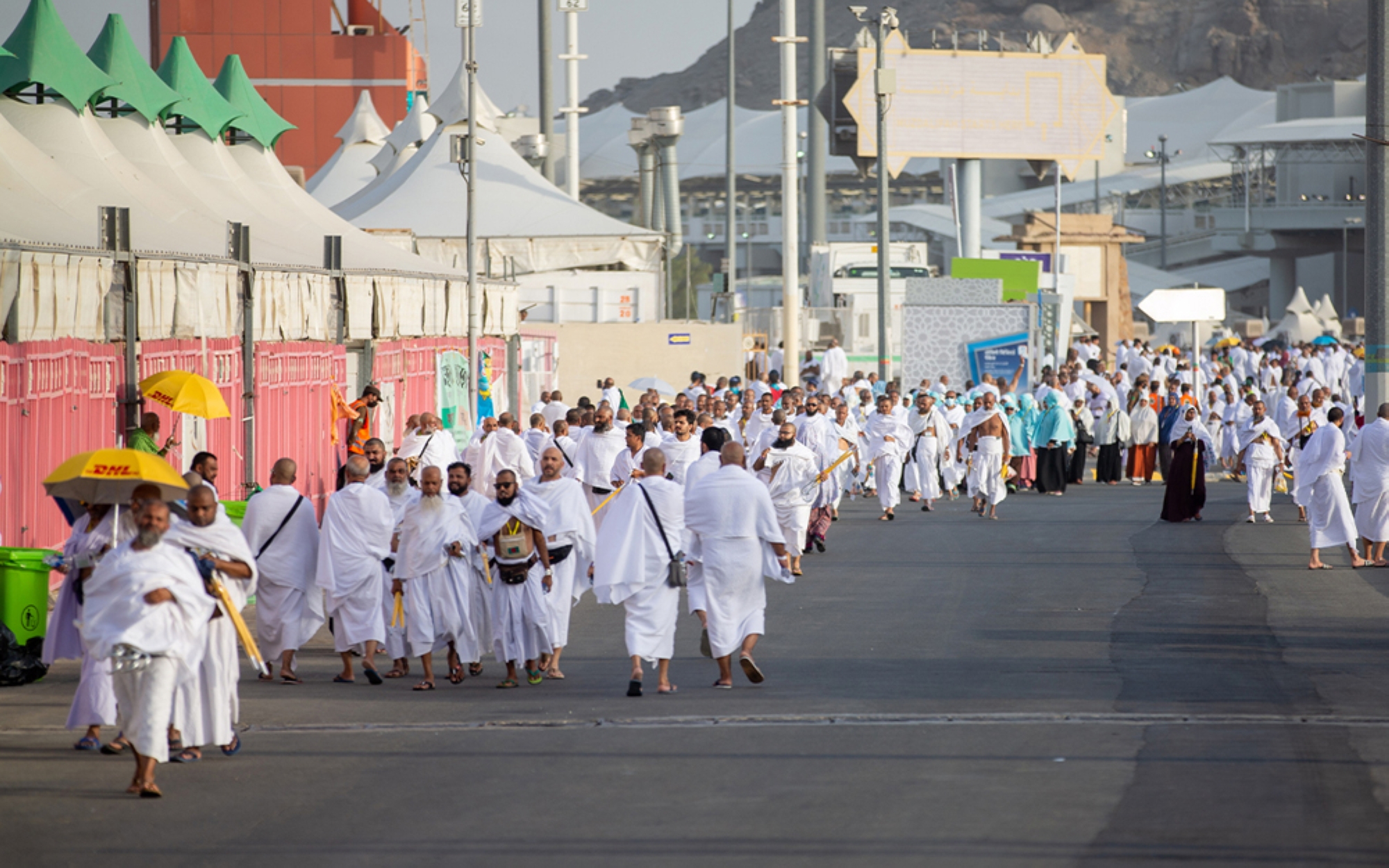
Saudi Arabia's services to facilitate the Hajj Journey
Saudi Arabia offers countries and Muslim communities around the world facilitations that shorten the time and procedures involved in the Hajj journey. It provides them with a variety of programs that help perform the Hajj pilgrimage in an easy and organized manner, contributing to showcasing the true image of Saudi Arabia in serving the pilgrims.
Saudi Arabia through the Ministry of Hajj and Umrah and a number of government, service, and research entities, is working on several initiatives with specific strategies to enhance the services and economies of Hajj, aiming to develop and grow the holy cities to meet the aspirations of pilgrims who come each year. This contributes to hosting the largest possible number of pilgrims by transforming Hajj services into a systematic and sustainable system that is not tied to a specific season, with global standards in transportation, housing, catering, and various logistic services.
Saudi Arabia has received over ninety-five million pilgrims from 1970 to 2018 and continues to provide services to approximately two million pilgrims each year.
Expansions of the Grand Mosque
Since its founding by King Abdulaziz Al Saud, Saudi Arabia has witnessed a series of expansions of the Holy Mosques to enhance their sacred status and facilitate the performance of rituals. King Abdulaziz initiated improvement and restoration works for the Grand Mosque in 1935, covering the circumambulation area, the Masa’a, all corridors, walls, minarets, and domes, as well as adding two Zamzam water dispensers to the existing one.
The expansion works continued under King Saud Bin Abdulaziz Al Saud, including the construction of three floors for the mosque and two floors for the Masa’a. The circumambulation area and the tawaf area were expanded, and roads leading to the mosque were paved and improved. Additionally, the Kaaba was equipped with a special electric staircase, with these works completed in 1956.
During the reign of King Faisal Bin Abdulaziz Al Saud, the structure around the Maqam Ibrahim was removed to expand the circumambulation area, and the Maqam was placed in a glass enclosure in 1967. He also ordered the relocation of the Kiswa Factory to its new location and the construction of a special building for the Grand Mosque Library.
King Khalid Bin Abdulaziz Al Saud directed the creation of a new door for the Kaaba in 1977, along with another door for the staircase to the roof of the Kaaba made of pure gold. He established the first maintenance and cleaning program for the Grand Mosque in 1978, while continuing various expansion works for the mosque.
During the reign of King Fahd Bin Abdulaziz Al Saud, roads were paved, and tunnels and bridges leading to the Grand Mosque were constructed. Worship areas in the mosque were equipped with chilled water and mobile hospitals, modern communication means, and comfortable air-conditioned transportation. Procedures for entering and leaving Saudi Arabia through land, sea, and air gateways were facilitated. In 1989, King Fahd instructed the expansion of the Grand Mosque, increasing its capacity to accommodate around one and a half million worshippers during Hajj, Umrah, and Ramadan. The roof of the mosque was tiled for use in prayers, tawaf, and sa'i, the tawaf area was covered with cool marble, and five electric escalators were installed for accessing the roof and first floor, along with the construction of five overhead bridges.
The expansion of the Sa'i area was completed during the reign of King Abdullah Bin Abdulaziz Al Saud, quadrupling its size. Additionally, the Tawaf area was expanded, and the Jamarat Bridge project was undertaken. The Mashaer Railway was launched to facilitate the smooth movement of pilgrims between the holy sites. Two satellite channels were dedicated to live broadcasting from the Holy Mosques in Makkah al-Mukarramah and al-Madinah al-Munawwarah twenty-four hours a day.
King Salman Bin Abdulaziz Al Saud has continued to prioritize the development of the Grand Mosque to facilitate the performance of rituals and increase its capacity. This includes the operation of ready sites in the expansion building, as well as the northern, western, and southern external courtyards, and parts of the eastern courtyards. All floors of the Custodian of the Two Holy Mosques project have been opened, raising the capacity of the Grand Mosque to 1.85 million worshippers and the Tawaf area to accommodate up to 107,000 circumambulations per hour.
The number of facilities increased to a total of 16,300 toilets and ablution places, with the provision of chilled water sources within the expansion building, the Mataf, and the external courtyards. Additionally, escalators and elevators, air conditioning systems, lighting, sound, television surveillance, and fire-fighting systems were put into operation.
To maximize the benefits of these improvements, the first ring road in Makkah al-Mukarramah was put into operation after its completion, and the two holy sites were connected by the Haramain High-Speed Railway, which links Makkah al-Mukarramah and al-Madinah al-Munawwarah, passing through King Abdulaziz International Airport in Jeddah, which receives the majority of pilgrims and Umrah performers from outside Saudi Arabia.
Security efforts during Hajj
The communication and media efforts of the Ministry of Interior contribute to educating the pilgrims about the instructions, guidelines, and regulations related to Hajj to ensure the safety of those coming to Saudi Arabia from around the world. This is done by dedicating its media platforms to social networks and text messages to guide the pilgrims in multiple languages during the pilgrimage and monitor the proper Hajj permits.
The security personnel from the Special Forces for Hajj and Umrah Security work around the clock to serve the pilgrims of the Grand Mosque, ensuring security and supporting organizational and guidance tasks. They manage the crowds during and after prayers. Additionally, female personnel contribute by assisting female pilgrims, maintaining security, and providing services according to a well-executed plan. This plan is implemented by equipped human resources and monitored through digital surveillance cameras managed from a dedicated operations room.
Catering efforts during Hajj
The Ministry of Health, the Ministry of Hajj and Umrah, the General Authority for Food and Drug Administration, and the Municipality of the Holy Capital, in cooperation with licensed catering companies and kitchens during the Hajj season, work to ensure the feeding of pilgrims and the preservation of their health during the performance of the rituals, by raising awareness among pilgrims about the safety of food, providing them with the necessary information to maintain food safety, and monitoring the meals provided for their suitability and fitness for consumption.
The role of the General Authority for Food and Drug Administration includes monitoring consignments and shipments arriving with pilgrim missions at King Abdulaziz International Airport in Jeddah, Prince Mohammed Bin Abdulaziz International Airport in al-Madinah al-Munawwarah, as well as Jeddah Islamic Port and land ports. The authority also monitors food establishments within the Municipality of the Holy Capital, including its tasks of health inspection of sacrificial animals slaughtered in the slaughterhouses located in Mina, food services provided in hotels hosting pilgrims, and food transport means entering Makkah al-Mukarramah. Additionally, it conducts guidance workshops for food handlers in catering kitchens.
Jamarat Bridge
As part of Saudi Arabia's efforts to facilitate the rituals of Hajj and ensure their safe conduct, the Jamarat Bridge in Mina has been expanded. It now spans 950 m in length and eighty m in width, with the bridge consisting of five levels, each twelve m high. It can accommodate up to three hundred thousand pilgrims per hour.
The facility comprises six service buildings, each consisting of twelve floors, and two buildings equipped with helipads for helicopters, with elevators dedicated to transporting ambulances between floors. Each service building includes three power stations and a backup power generator. Each building has twenty-eight electric stairs connected to a BMS system for control, along with twenty electric stairs around the bridge.
The bridge is connected to thirteen systems, including: CCTV surveillance systems using around nine hundred cameras, a television broadcasting system covering four TV channels, a directional messaging system, an electronic crowd counting system, a public address system through three thousand loudspeakers, a Building Management System (BMS) and Supervisory Control and Data Acquisition (SCADA) system, an Uninterruptible Power Supply (UPS) system, two fire alarm and firefighting systems, a waste disposal system, a carbon monoxide level measurement system, a visibility level measurement system in tunnels, 226 environmentally friendly electric carts, along with 456 desert coolers that spray mist on pilgrims and the surrounding areas to help reduce the temperature, ninety misting fans, seventy-eight central air conditioners, 182 air conditioners with separate units, and 104 water pumps.
To enhance the flow and increase the capacity of the bridge, the Jamarat basins and pillars were designed with a length of forty m in an oval shape to reduce congestion and minimize crowding among pilgrims during the stoning ritual at Jamarat.
Developed tents in Mina
The developed tents project in Mina is one of Saudi Arabia's initiatives to facilitate the stay of pilgrims in comfortable locations that meet safety and security standards. These tents are made of fire-resistant glass-coated fabric with Teflon, preventing the emission of toxic gases. They are interconnected by walkways, and each group of tents is surrounded by metal fences with main and emergency doors
The tents occupy 20 percent of the area of Mina, and the project includes thirty thousand fire sprinklers, over three thousand surveillance cameras, and about twelve thousand guidance and alert speakers. Additionally, there are more than fifteen thousand air conditioning and ventilation units, along with restrooms, ablution areas in the middle of the camp, a waste disposal site, and special tanks for firefighting water in the form of tunnels atop the mountains in Mina to supply a one hundred km network of firefighting pipes. The typical tent dimensions are eight by eight m, with other tents ranging in size from six by eight m to twelve by eight m.
Facilitating Hajj visa procedures
Saudi Arabia has facilitated Hajj services by making the Hajj visa part of the electronic services that can be completed through clear and defined digital procedures. This helps in adopting the principle of transparency in transactions related to the Hajj pilgrimage. The Electronic Control and Monitoring Center, affiliated with the Ministry of Hajj and Umrah, is one of the initiatives concerned with Hajj services in Saudi Arabia. It aims to bring the centers specialized in serving pilgrims closer to decision-makers, to ensure a higher level of coordination among the parties involved in Hajj services, and to provide a digital control panel for government entities working in pilgrim services. The e-track initiative, in turn, protects the rights of pilgrims and ensures justice in the Hajj for those interested, in addition to speeding up and facilitating the mechanisms for electronic visas.
Institutions and pilgrimage companies contribute to supporting the economies of Hajj and expanding the expected opportunities, transferring the culture of Hajj work from seasonal to permanent activities throughout the year in cooperation with private sector entities. This is to ensure improved coordination and readiness. The Electronic Bracelet Project is one of the initiatives concerned with Hajj services. These bracelets carry personal information and coordinates of pilgrims' residential locations during their journey, passing through the holy sites, Makkah al-Mukarramah, and al-Madinah al-Munawwarah.
The Ministry of Hajj and Umrah coordinates with sectors involved in Hajj, such as pilgrimage companies, Hajj services, and the Coordinating Council for Domestic Pilgrims' Service Facilities, to enhance services in line with the Saudi Vision 2030. It also expands cooperation with various countries participating in Hajj, signing seventy-eight agreements for Hajj with seventy-eight countries, including Islamic countries and countries with Muslim minorities, regarding pilgrims' affairs in terms of organization, awareness, and dispatching.
Transportation during Hajj
Saudi Arabia provides several facilitative services for transporting pilgrims, under the supervision of the Ministry of Hajj and Umrah and the Ministry of Transport and Logistics Services, in cooperation with licensed unions. These services ensure the arrival of visitors to the Grand Mosque in Makkah al-Mukarramah and facilitate their movement between the holy sites.
The operational plans for the transportation and logistical services sectors in Saudi Arabia include preparing road networks, ensuring the readiness of airports and seaports, and the railway networks and public transport buses. Pilgrims arrive in Makkah al-Mukarramah via flights to King Abdulaziz International Airport in Jeddah or Taif International Airport, then proceed to Makkah al-Mukarramah and move between the holy sites using a variety of dedicated transportation methods, including:
Haramain High Speed Railway
The Haramain High Speed Railway is a double-track electrified railway that was launched in 2018. It connects the cities of Makkah al-Mukarramah and al-Madinah al-Munawwarah with a journey time of approximately two hours and twenty minutes, covering a distance of 450 km at a speed of three hundred km/h. The railway uses advanced signaling and communication systems, and is part of the plan to develop and expand the Saudi railway network. It contributes to meeting the increasing demand for transportation services for both domestic and international pilgrims safely. The railway passes through five stations: Makkah al-Mukarramah Station in ar-Rusaifah neighborhood, al-Madinah al-Munawwarah Station, King Abdulaziz Airport Station in Jeddah, Jeddah Central Station in al-Sulaymaniyah neighborhood, and King Abdullah Economic City Station.
Al-Mashaaer al-Mugaddassah Metro Line
Saudi Arabian Railways (SAR) operates al-Mashaaer al-Mugaddassah Metro Line to transport pilgrims across nine stations, starting from Arafat, passing through Muzdalifah, and ending at Mina. The Mashair Metro Line fleet consists of sixteen trains with a speed of eighty km/h. The stations are connected by an eighteen km double-track railway. Each train has a capacity of three thousand passengers, with a total capacity of seventy-two thousand passengers per hour.
Shuttle transportation
It is one of the modern operational modes integrated with the Hajj systems, organized by the General Syndicate of Cars. It is activated annually at the same time during the Hajj season, consisting of a two-lane bus route, centered within the pilgrims' city.
The shuttle service launches regular trips during the Hajj season, starting with receiving buses from transport companies, distributing them, and launching them according to the schedules of the "Dhaif" app. These trips include routes to and from Makkah al-Mukarramah outside the holy sites and others between the holy sites during the performance of the rituals.
Non-profit sector in Hajj
There are several initiatives related to the non-profit sectors in Hajj, including the development of strategies and governance for the non-profit sector by introducing ambitious strategies to analyze regulations, improve performance in serving Hajj, and create a governance structure for the sector. Additionally, these initiatives support technical and media work, facilitate funding, and establish incubators and accelerators for collaborative efforts through providing consultations and training.
The "Be a Helper" initiative for volunteers in Hajj
Through the "Be a Helper" initiative, government entities during Hajj provide opportunities for individuals wishing to volunteer their services to pilgrims. Volunteers can participate in various service fields in Makkah al-Mukarramah, al-Madinah al-Munawwarah, and the holy sites, including guiding lost pilgrims, organizing pedestrian traffic, distributing chilled water and food packages, offering translation services in pilgrims' languages, and providing field and office services.
The Social and Voluntary Services Agency in Hajj
The Social and Voluntary Services Agency contributes to providing a number of social, voluntary, and humanitarian services during the Hajj season, in line with Saudi Vision 2030, to enable pilgrims to perform their rituals peacefully. These services include preparing facilities for people with disabilities, providing free carts for those in need, supporting relevant entities at the Grand Mosque with trained volunteers, distributing guidance signs and wristbands, offering hospitality and gifts, showing appreciation and good reception, visiting hospitals and care homes, and promoting the growing culture of volunteer work during the Hajj days.
Protecting the rights of pilgrims
Saudi Arabia safeguards the rights of pilgrims throughout their stay in its territories, from their arrival at entry points until their departure after completing their rituals. The Ministry of Hajj and Umrah, along with several government entities, ensure that pilgrims enjoy a range of rights. These include qualifying institutions and companies capable of providing appropriate services, facilitating contracts with licensed companies under direct supervision to guarantee the rights of both parties, as well as taking the necessary financial guarantees from service providers to ensure the implementation of the contracts concluded between them and the companies.
Government entities in Saudi Arabia allow pilgrims to raise their observations and complaints against service providers. They refer these observations to specialized committees to investigate the issues and issue appropriate decisions. The Ministry of Hajj and Umrah is committed to returning the rights of pilgrims as determined by the violations committee. The ministry also penalizes institutions and companies that fail to serve pilgrims properly by suspending or fining them according to the type and size of the violation. Additionally, the ministry represents pilgrims in legal proceedings if service providers object to the compensation awarded to the pilgrim, and it ensures that the compensation is paid to the pilgrims through approved payment channels.
Pilgrim's bank card
Saudi Arabia has introduced a bank card for pilgrims issued by local banks to enable the pilgrims to deposit money in it, whether in their countries or after arriving in Saudi Arabia, to ensure the protection of their money from loss, damage, and theft. These cards can be used within the Mada network and all points of sale in Saudi Arabia.
Services of the Internet of Things (IoT) in Hajj
Saudi Arabia relies on the Internet of Things (IoT) network in Hajj to facilitate the implementation of crowd management and escalation plans. It also monitors congestion areas through dedicated transmission and reception stations. The country has hundreds of sensors in Mina and the Jamarat facility, along with thousands of cables dedicated to fiber optics, all aimed at collecting and transmitting data related to pedestrian routes and congestion locations.
In the field of digital technologies for Hajj, pilgrims carry cards and wristbands from which information is retrieved by specific smart devices using Near Field Communication (NFC) technology. This contributes to several services, including controlling access to camps and their facilities, reducing unauthorized pilgrimage, and guiding lost pilgrims.
The initiative of the Monitoring and Crowd Management Center works on facilitating and monitoring the movement of pilgrims, as well as analyzing data from the Internet of Things network within the holy sites to make decisions and reach faster solutions through artificial intelligence technologies.
Pilgrim's health insurance
Saudi Arabia provides pilgrims with travel insurance that covers their health needs and any emergencies related to accidents or travel delays. The insurance ensures fair treatments and quick solutions in case of emergencies, aiming to improve the pilgrims' experience and facilitate their pilgrimage until their return home. This insurance is one of the tools to increase efficiency in health services and reduce reliance on government support in the health sector.
The health insurance for pilgrims is supported by a unified call center staffed by service providers supporting beneficiaries. The center operates twenty-four hours a day, and its employees speak several languages. Additionally, the insurance receives support through comprehensive service centers called 'Inaya', as well as a number of trained field teams to simplify communication with beneficiaries, including visitors, pilgrims, and people with special needs. These teams answer inquiries, receive complaints, provide necessary solutions, and raise awareness among the pilgrims regarding insurance matters and regulations
The insurance relies on a variety of innovative methods and means to reduce risks and provide healthcare services, ensuring benefits that mitigate the effects of potential accidents that may occur during the performance of rituals, while staying in the holy places, or during travel between them.
The insurance document for pilgrims aims to facilitate their spiritual journey, avoid unforeseen problems, and expedite the handling of emergencies that may occur. It also works to improve the level of healthcare services for visitors to the Two Holy Mosques from their arrival in Saudi Arabia until their departure. The document provides emergency healthcare services, and information about pilgrims' insurance and its details can be accessed through the insurance authority's website.
Pilgrim Experience Program
The Saudi Vision 2030 has adopted the Pilgrim Experience Program as one of its realization programs. Through this program, the goal is to host fifteen million pilgrims by 2025 and thirty million by 2030. Additionally, the aim is to improve the quality of services provided to pilgrims during their stay in Saudi Arabia.
The program provides millions of Muslims with the opportunity to enrich and deepen their experience by preparing the Two Holy Mosques, fulfilling the global message of Islam, preparing tourist and cultural sites, and providing the best services before, during, and after their visit to Makkah al-Mukarramah, al-Madinah al-Munawwarah, and the holy sites.
The program aims to study the development and operation of transportation services for pilgrims and Umrah performers, establish a training center under the Ministry of Hajj and Umrah to train workers in the Hajj and Umrah systems, study and operate the Center for Studies and Projects, in addition to transforming the institutions of the Coordination Council into a joint-stock company and restructuring its services.
The program contributes to the development of services provided to domestic Umrah performers, as well as the establishment and operation of a Crowd Management throughout the entire Hajj journey. It also includes studying the construction and operation of pilgrim and Umrah performer cities, as well as studying the construction and operation of the electronic gates project in Makkah al-Mukarramah, al-Madinah al-Munawwarah, and the holy sites.
Objectives of the Pilgrim Experience Program
The program aims to achieve three main objectives: firstly, to facilitate the hosting of more Umrah performers and facilitate access to the Holy Mosques; secondly, to provide high-quality services to pilgrims and Umrah performers; and thirdly, to enrich the religious and cultural experience of pilgrims and Umrah performers.
Makkah Route Initiative
It was launched by the Ministry of Interior in 2017, as part of the "Pilgrim Experience Program", one of the programs of Saudi Vision 2030. Until 2024, seven countries have benefited from it, namely: Malaysia, Morocco, Indonesia, Pakistan, Bangladesh, Turkey, and Côte d'Ivoire. It enabled them to enjoy high-quality services during their journey to Saudi Arabia and shortened the time at passport control to complete the procedures within a few minutes. Afterward, pilgrims and their luggage are transported directly to their accommodations in Makkah al-Mukarramah or al-Madinah al-Munawwarah.
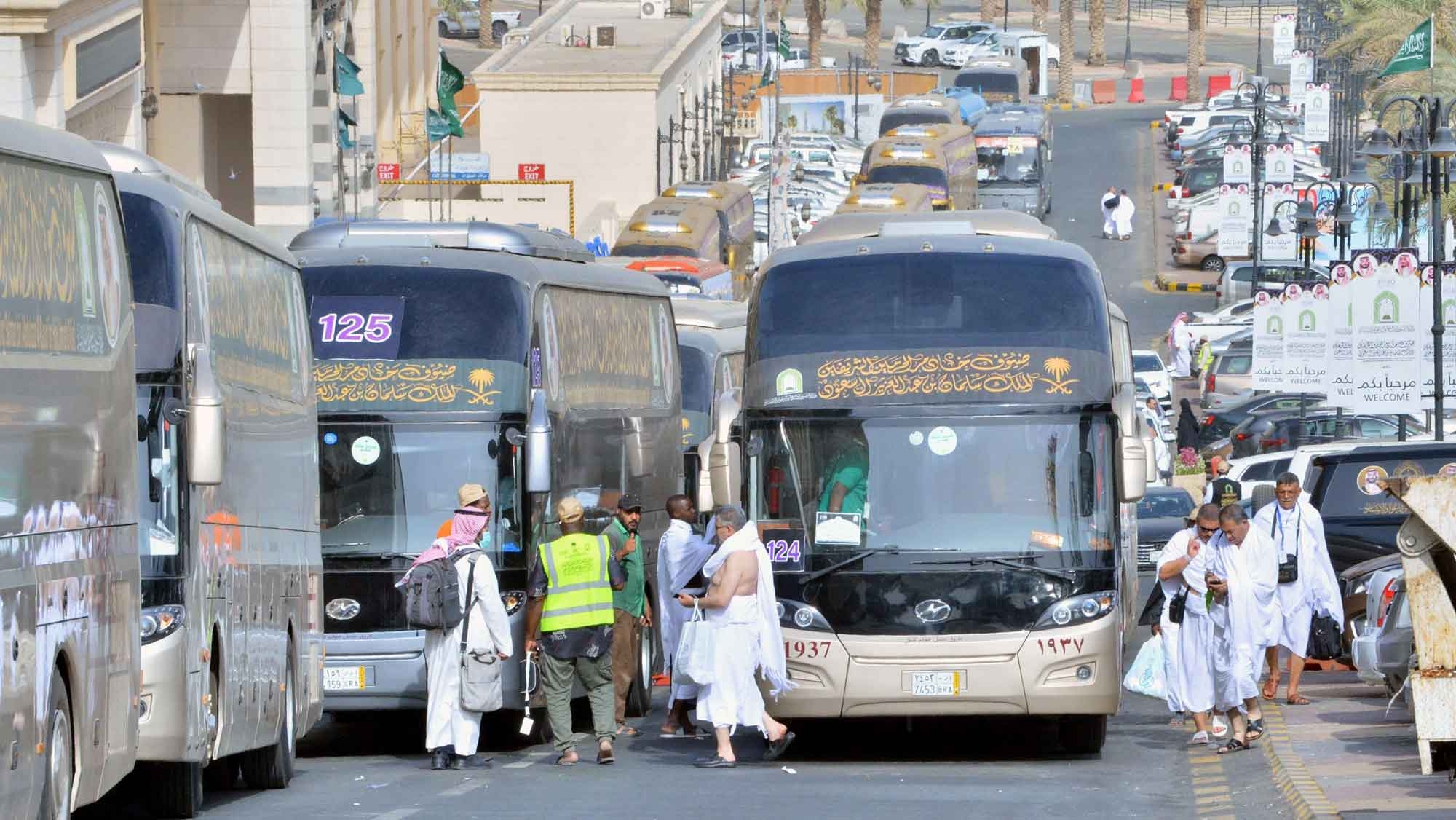
Custodian of the Two Holy Mosques' Guests Program for Hajj and Umrah
Saudi Arabia annually hosts thousands of pilgrims from all Islamic countries and Muslim minority countries for Hajj, at the expense of the Custodian of the Two Holy Mosques, to perform Hajj rituals and visit the Prophet's Mosque. This program, launched by Saudi Arabia in 1997, aims to strengthen relationships between Saudi Arabia and Muslims worldwide and to develop them academically and intellectually during the Hajj season.
Through the program, Muslims from Islamic countries and Muslim minority countries get to know each other, exchange opinions and ideas, strengthen relationships, and share scientific and religious experiences.
The program offers religious and guidance services to its guests in the holy sites, Makkah al-Mukarramah, and al-Madinah al-Munawwarah. Additionally, it provides a medical mission that accompanies the guests throughout their pilgrimage.
The program includes activities such as meetings with scholars and preachers, participation in lessons, lectures, and seminars led by senior scholars and preachers, as well as meetings with the Imams of the Two Holy Mosques. These activities focus on inviting people to the path of Allah with wisdom, good advice, moderation, and dialogue.
Goals of the Custodian of the Two Holy Mosques' Guests Program for Hajj and Umrah
The program aims to introduce the methodology of moderate Islamic moderation, strengthen the bond between Saudi Arabia and Muslims, enhance the sense of Islamic brotherhood, and develop the scientific, intellectual, and missionary skills of the guests. It also works to facilitate Hajj services for the guests of the Custodian of the Two Holy Mosques and provide services to them until they complete their Hajj and return home safely.
The program provides the opportunity for the largest number of Muslims to perform Hajj and Umrah, especially those who have not been able to perform these rites so that they can perform them easily.
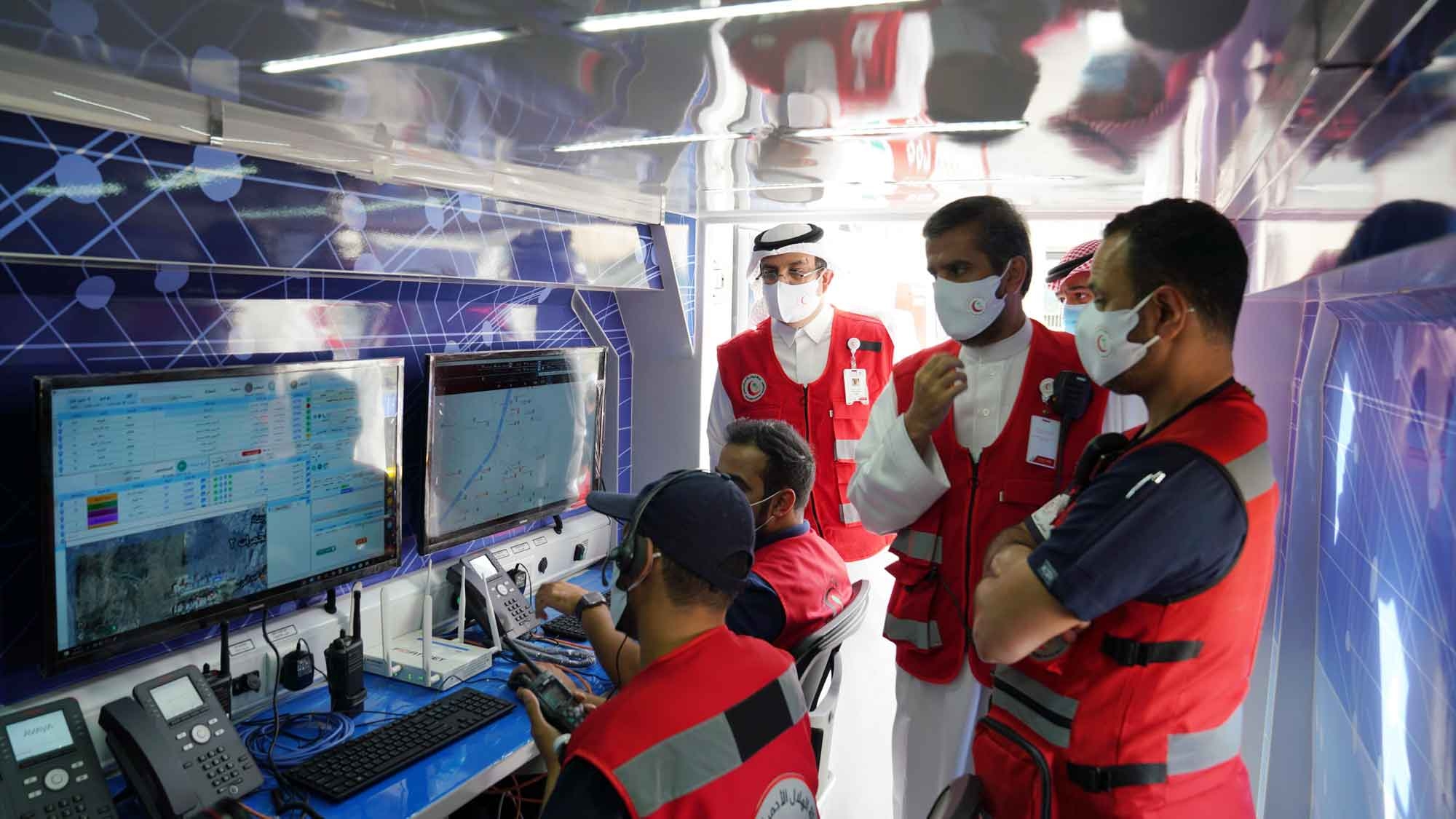
Medical care for the guests of the Custodian of the Two Holy Mosques for Hajj and Umrah
The medical services are provided through the Services Committee of the Custodian of the Two Holy Mosques' Guests Program for Hajj and Umrah. The program offers equipped medical clinics for men and women, along with ambulance services for critical cases, in cooperation with the Ministry of Health to provide medical, health, and guidance services to pilgrims around the clock, whether in Makkah al-Mukarramah, the holy sites, or al-Madinah al-Munawwarah.
The clinics are equipped with therapeutic and preventive medications, as well as emergency diagnostic and treatment devices, such as blood pressure monitors, glucose monitors, oxygen saturation monitors, and therapeutic steam inhalers. The clinics operate around the clock under the supervision of a medical team.
The guidance and counseling in the Custodian of the Two Holy Mosques' Guests Program for Hajj and Umrah
The program conducts a series of educational and guidance lectures and seminars. The Sharia Committee within the program delivers hundreds of guidance lectures after each prayer, delivered by a number of scholars and preachers from the ministry at the program's guest locations. These lectures involve a group of scholars, students of knowledge, judges, and faculty members from Saudi universities. Specialized translators are also involved, providing real-time translation into several international languages.
The lectures in the program revolve around the rituals of Hajj and Umrah, the Prophet's biography (Seerah), the pillars of faith (Iman), the pillars of Islam, Islamic etiquette and morals, the Muslim family, supplications and remembrances, and the rights and duties of every Muslim, both men and women.
The technological system for the Custodian of the Two Holy Mosques' Guests Program for Hajj and Umrah
The system aims to establish a central database containing all the data related to the program's guests, in addition to providing a package of reports and statistics to support the program's activities and decision-makers.
The Custodian of the Two Holy Mosques' gift to pilgrims
Saudi Arabia offers departing pilgrims a gift from the Custodian of the Two Holy Mosques, which consists of the Holy Quran and a translation of its meanings. The gift from the Custodian of the Two Holy Mosques, consisting of the Holy Quran, is printed at the King Fahd Complex for the Printing of the Holy Quran in al-Madinah al-Munawwarah. It is available in various editions, sizes, and translations, and is distributed to pilgrims upon their departure from Saudi Arabia.
Related quizzes

